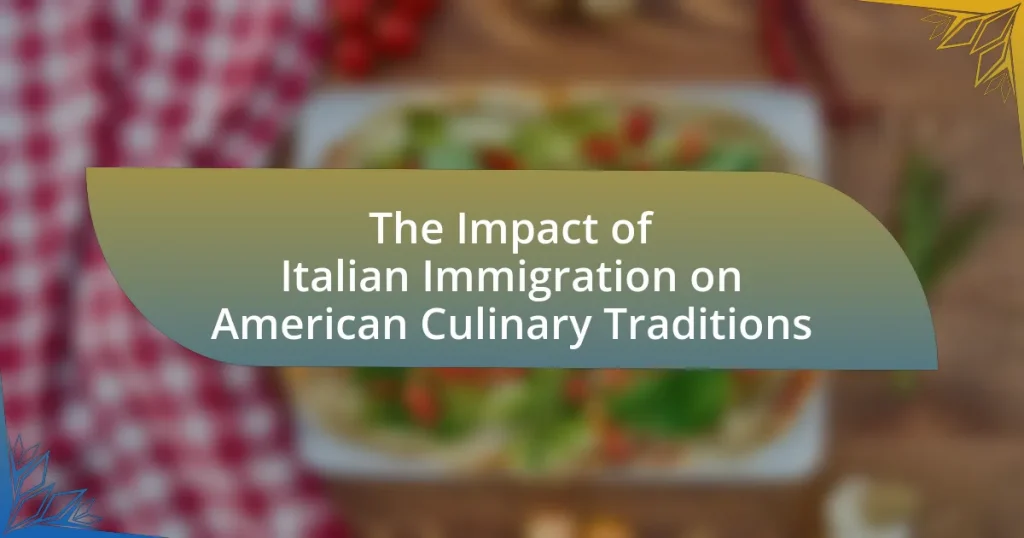The article examines the significant impact of Italian immigration on American culinary traditions, highlighting how the arrival of Italian immigrants in the late 19th and early 20th centuries introduced essential ingredients, cooking techniques, and dishes that have become integral to American cuisine. It discusses the historical context of Italian immigration, the adaptation of traditional recipes to local tastes, and the establishment of Italian-American restaurants that popularized dishes such as pizza, pasta, and espresso. Additionally, the article explores the ongoing influence of Italian culinary practices in contemporary American cooking and the cultural significance of Italian food in American celebrations and traditions.

What is the Impact of Italian Immigration on American Culinary Traditions?
Italian immigration has profoundly shaped American culinary traditions by introducing diverse ingredients, cooking techniques, and dishes that have become staples in the American diet. The arrival of Italian immigrants in the late 19th and early 20th centuries brought foods such as pasta, pizza, and various sauces, which have been integrated into mainstream American cuisine. For example, the popularity of pizza skyrocketed in the United States after World War II, evolving into numerous regional styles, including New York and Chicago deep-dish. Additionally, Italian culinary practices, such as the emphasis on fresh ingredients and family-style dining, have influenced American cooking methods and dining culture. The establishment of Italian-American restaurants and the proliferation of Italian recipes in American households further solidified this impact, making Italian cuisine one of the most beloved and widely consumed in the country.
How did Italian immigration begin to influence American cuisine?
Italian immigration began to influence American cuisine in the late 19th and early 20th centuries as large numbers of Italians settled in urban areas, bringing their culinary traditions with them. This influx introduced staple dishes such as pasta, pizza, and risotto, which were adapted to local ingredients and tastes. By the early 20th century, Italian restaurants proliferated in cities like New York and Chicago, making Italian food a significant part of the American dining landscape. The establishment of Italian-American communities further solidified these culinary influences, leading to the popularization of Italian dishes across the United States.
What historical events facilitated Italian immigration to the United States?
The historical events that facilitated Italian immigration to the United States include widespread poverty and political unrest in Italy during the late 19th and early 20th centuries. The unification of Italy in 1861 led to economic challenges, particularly in the southern regions, where many Italians faced dire living conditions. Additionally, the rise of fascism in the 1920s and 1930s prompted many to flee oppressive regimes. Between 1880 and 1920, approximately 4 million Italians immigrated to the U.S., significantly impacting American society and culture, including culinary traditions. This mass migration was driven by the search for better economic opportunities and the desire to escape political turmoil, making it a pivotal moment in both Italian and American history.
How did the arrival of Italian immigrants change local food practices?
The arrival of Italian immigrants significantly transformed local food practices by introducing new ingredients, cooking techniques, and culinary traditions. Italian immigrants brought staples such as pasta, tomatoes, and olive oil, which became integral to American cuisine. They also popularized dishes like pizza and spaghetti, which were previously less common in the United States. This culinary influence led to the establishment of Italian restaurants and the incorporation of Italian flavors into mainstream American cooking, reflecting a broader trend of cultural exchange and adaptation in food practices.
What are the key Italian culinary contributions to American food culture?
Key Italian culinary contributions to American food culture include pizza, pasta, and espresso. Pizza, originating from Naples, became a staple in American cuisine, particularly in cities like New York and Chicago, where regional variations emerged. Pasta, especially varieties like spaghetti and macaroni, gained immense popularity, leading to dishes such as spaghetti and meatballs, which reflect Italian-American adaptations. Espresso culture, introduced by Italian immigrants, influenced coffee consumption in the U.S., leading to the rise of espresso-based drinks in cafes. These contributions have significantly shaped American dining habits and preferences, making Italian cuisine one of the most beloved in the country.
Which Italian dishes became popular in America?
Italian dishes that became popular in America include pizza, spaghetti and meatballs, lasagna, and risotto. Pizza, originating from Naples, gained immense popularity in the United States, particularly after World War II, when returning soldiers brought back a taste for it. Spaghetti and meatballs, often considered a quintessential Italian-American dish, evolved from traditional Italian pasta dishes, adapting to American tastes. Lasagna, with its layers of pasta, cheese, and meat, became a staple in many households, while risotto, though less common, has also found a place in American cuisine, especially in upscale dining. These dishes reflect the adaptation and integration of Italian culinary traditions into American food culture.
How did Italian cooking techniques integrate into American kitchens?
Italian cooking techniques integrated into American kitchens primarily through the influence of Italian immigrants who brought their culinary traditions to the United States in the late 19th and early 20th centuries. These immigrants established restaurants and pizzerias, introducing dishes such as pasta, pizza, and risotto, which became staples in American cuisine. The adaptation of these techniques included the use of local ingredients and the incorporation of American flavors, leading to the creation of hybrid dishes like spaghetti and meatballs. The popularity of Italian cuisine surged post-World War II, as returning soldiers sought familiar flavors, further embedding these techniques into American culinary practices.
Why is Italian cuisine considered a significant part of American culinary identity?
Italian cuisine is considered a significant part of American culinary identity due to its widespread popularity and integration into everyday American meals. The mass immigration of Italians to the United States in the late 19th and early 20th centuries introduced a variety of dishes, such as pasta, pizza, and risotto, which have since become staples in American households. By the mid-20th century, Italian restaurants proliferated across the country, reflecting the cuisine’s acceptance and adaptation within American culture. According to the National Restaurant Association, Italian cuisine consistently ranks among the top three most popular ethnic cuisines in the U.S., highlighting its enduring influence on American dining preferences.
What role does Italian food play in American celebrations and traditions?
Italian food plays a significant role in American celebrations and traditions by serving as a central element in various festive occasions. Dishes such as pasta, pizza, and lasagna are commonly featured at family gatherings, holidays, and community events, reflecting the cultural heritage brought by Italian immigrants. For instance, during holidays like Christmas and Easter, Italian-American families often prepare traditional meals that include items like the Feast of the Seven Fishes on Christmas Eve, showcasing the importance of Italian culinary practices in American festive customs. Additionally, Italian food is frequently associated with celebrations such as weddings and birthdays, where large gatherings often feature Italian dishes, reinforcing the cultural significance of this cuisine in American social life.
How has Italian cuisine influenced regional American dishes?
Italian cuisine has significantly influenced regional American dishes by introducing ingredients, cooking techniques, and flavor profiles that have become staples in various American culinary traditions. For example, the widespread use of tomatoes, garlic, and olive oil in American cooking can be traced back to Italian immigrants who brought these ingredients with them in the late 19th and early 20th centuries. Additionally, dishes such as pizza and pasta have evolved in the United States, adapting to local tastes and ingredients, resulting in unique regional variations like Chicago deep-dish pizza and New York-style pizza. The fusion of Italian culinary practices with local American ingredients has led to the creation of hybrid dishes, such as the Italian-American meatball sub, which showcases the blending of Italian flavors with American sandwich culture. This influence is evident in the popularity of Italian-American restaurants across the country, which serve as a testament to the lasting impact of Italian cuisine on American food culture.
How did Italian immigration shape the restaurant industry in America?
Italian immigration significantly shaped the restaurant industry in America by introducing diverse culinary traditions and establishing a widespread appreciation for Italian cuisine. Beginning in the late 19th and early 20th centuries, millions of Italians migrated to the United States, bringing with them regional recipes and cooking techniques that transformed American dining.
Italian immigrants opened numerous restaurants, pizzerias, and cafes, particularly in urban areas, which became social hubs for both Italian communities and the broader public. By the 1920s, Italian food had gained popularity, leading to the establishment of Italian-American cuisine as a distinct category within the American culinary landscape.
The proliferation of Italian restaurants contributed to the mainstream acceptance of dishes like pasta, pizza, and espresso, which were previously unfamiliar to many Americans. According to the National Restaurant Association, Italian cuisine remains one of the most popular types of food in the United States, illustrating the lasting impact of Italian immigration on the restaurant industry.
What types of Italian restaurants emerged in the United States?
Various types of Italian restaurants emerged in the United States, including pizzerias, trattorias, and fine dining establishments. Pizzerias became popular in the early 20th century, particularly in cities with large Italian immigrant populations, serving pizza as a staple dish. Trattorias, which offer a casual dining experience with a focus on traditional Italian dishes, also gained traction during this period. Fine dining Italian restaurants began to appear in the mid-20th century, showcasing regional Italian cuisine and elevating the dining experience. These restaurant types reflect the diverse culinary influences brought by Italian immigrants and their adaptation to American tastes.
How did Italian immigrants contribute to the growth of the American food service sector?
Italian immigrants significantly contributed to the growth of the American food service sector by introducing diverse culinary traditions and establishing numerous restaurants and eateries across the United States. Their arrival in the late 19th and early 20th centuries coincided with urbanization, leading to the proliferation of Italian restaurants that popularized dishes such as pasta, pizza, and espresso. By 1920, there were over 1,000 Italian restaurants in New York City alone, showcasing the rapid expansion of this cuisine within the American dining landscape. This influx not only diversified the food options available to Americans but also influenced the broader food culture, leading to the integration of Italian ingredients and cooking techniques into mainstream American cuisine.
What challenges did Italian immigrants face in introducing their culinary traditions?
Italian immigrants faced significant challenges in introducing their culinary traditions, primarily due to cultural differences and economic barriers. Many American consumers were unfamiliar with Italian ingredients and cooking methods, leading to resistance and misunderstanding of dishes like pasta and risotto. Additionally, Italian immigrants often struggled with limited access to authentic ingredients, as many traditional items were not readily available in the United States during the late 19th and early 20th centuries. This lack of access hindered their ability to prepare and share their culinary heritage authentically. Furthermore, the economic conditions forced many immigrants to adapt their recipes to utilize cheaper, more accessible ingredients, which diluted the authenticity of their traditional cuisine. These factors collectively impeded the full acceptance and integration of Italian culinary traditions into American culture.
How did cultural perceptions affect the acceptance of Italian food in America?
Cultural perceptions significantly influenced the acceptance of Italian food in America by initially framing it as foreign and inferior, which changed over time as Italian immigrants integrated into American society. Early 20th-century attitudes often viewed Italian cuisine as peasant food, leading to its marginalization. However, as Italian communities established themselves and contributed to American culture, perceptions shifted, particularly after World War II, when Italian food began to be embraced for its flavors and communal dining practices. The popularity of Italian-American dishes, such as pizza and pasta, surged, supported by the rise of Italian restaurants and the influence of media, which showcased Italian cuisine as both exotic and desirable. This transformation illustrates how changing cultural perceptions can elevate a cuisine from outsider status to a beloved part of the American culinary landscape.
What adaptations did Italian immigrants make to their cuisine in America?
Italian immigrants adapted their cuisine in America by incorporating local ingredients and modifying traditional recipes to suit American tastes. For instance, they began using more tomato-based sauces, which were less common in Italy, and embraced the use of mozzarella cheese, which became a staple in dishes like pizza. Additionally, they often adjusted the seasoning and preparation methods to align with the preferences of American consumers, leading to the creation of dishes such as spaghetti and meatballs, which do not have a direct counterpart in traditional Italian cuisine. These adaptations reflect the blending of Italian culinary traditions with American food culture, resulting in a unique Italian-American cuisine that has become widely popular across the United States.
How can we appreciate the ongoing influence of Italian culinary traditions today?
We can appreciate the ongoing influence of Italian culinary traditions today by recognizing their integration into American cuisine, which has led to the widespread popularity of dishes such as pizza and pasta. Italian immigrants brought their culinary practices to the United States in the late 19th and early 20th centuries, significantly shaping the American food landscape. For instance, the introduction of Neapolitan pizza in cities like New York and Chicago has evolved into various regional styles, showcasing the adaptability of Italian cooking. Additionally, the use of ingredients like olive oil, garlic, and fresh herbs in everyday American cooking reflects the lasting impact of these traditions. According to the National Pasta Association, pasta consumption in the U.S. has increased significantly, with Americans eating over 20 pounds of pasta per person annually, highlighting the deep-rooted appreciation for Italian culinary influences.
What are some modern interpretations of traditional Italian dishes in America?
Modern interpretations of traditional Italian dishes in America include variations such as cauliflower pizza crust, which caters to gluten-free diets, and the use of artisanal cheeses in classic dishes like lasagna. These adaptations reflect a blend of health-conscious trends and gourmet influences, showcasing ingredients like quinoa in risottos and the incorporation of local produce in pasta dishes. The rise of food trucks and casual dining has also led to innovative takes on traditional recipes, such as spaghetti tacos and gourmet meatball sliders, which appeal to contemporary American tastes while maintaining a connection to Italian culinary roots.
How can home cooks incorporate Italian culinary techniques into their cooking?
Home cooks can incorporate Italian culinary techniques into their cooking by mastering foundational methods such as making fresh pasta, using high-quality olive oil, and employing traditional seasoning techniques. For instance, making fresh pasta involves mixing flour and eggs to create a dough, which is then rolled out and cut into various shapes, a practice rooted in Italian tradition that enhances texture and flavor. Additionally, using high-quality olive oil as a base for dressings and cooking not only adds depth to dishes but also reflects the Italian emphasis on quality ingredients. Seasoning with fresh herbs like basil and oregano, rather than dried alternatives, showcases the Italian approach to flavor, emphasizing freshness and authenticity. These techniques are integral to Italian cuisine and can significantly elevate the quality of home-cooked meals.















